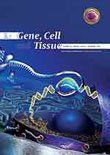فهرست مطالب

Gene, Cell and Tissue
Volume:3 Issue: 3, Jul 2016
- تاریخ انتشار: 1395/06/10
- تعداد عناوین: 7
-
-
Page 1BackgroundExtracellular matrix (ECM) functions as a scaffold for tissue morphogenesis and regeneration, promotes the maintenance of differentiated tissue and plays an extremely indispensable role in cell proliferation and differentiation. As a corollary of this importance, studying the cell behaviors without considering the ECM is to some extent impossible. Deletion of cells from ECM obtains natural three dimensional matrices that ape the in vivo functions of ECM..ObjectivesThe current study aimed to verify whether acellular dermal matrix (ADM) is a suitable 3D-matrix for blastema tissue cells originated from pinna of rabbit and study different behaviors of these cells on ADM..Materials And MethodsTo prepare ADM, small pieces of skin were decellularized by repeated snap freeze-thaw and treatment with sodium dodecyl sulfate as a detergent. Decellularization was verified and proved by histological tests. Blastema rings were prepared by double punching the pinnas of male New Zealand White rabbits and cultured in vitro after assembling with ADM. Specimens were studied after 5, 10, 15, 20 and 25 days of culturing..ResultsMigration of cells started on the fifth day. As a result of this migration, most cells were located on the surface of the scaffold and formed epiderm-like structure and some penetrated into the scaffold. By day 25, cells which had penetrated into the scaffold had various destinies such as becoming elongated spindle-shaped cells and creating blood vessel-like structures..ConclusionsADM can induce migration and probably differentiation of blastema tissue cells; therefore, it is a suitable 3D-model to study cell behaviors in vitro..Keywords: Acellular Dermal Matrix, Blastema Tissue, Extracellular Matrix, Decellularization
-
Page 3BackgroundSuperoxide dismutase is one of the most important antioxidant enzymes that protect cells against destructive effects of superoxide anion..ObjectivesThe aim of this study was to evaluate the association between the C47T polymorphism (rs4880) of the manganese superoxide dismutase (Mn-SOD) gene and the risk of malignant lymphoproliferative disorders (MLDs)..
Patients andMethodsManganese superoxide dismutase polymorphism was genotyped using polymerase chain reaction-restriction fragment length polymorphism (PCR-RFLP) in 103 patients with MLDs and 103 healthy control subjects..ResultsThe frequencies of the CC, CT and TT genotypes were 29.1%, 51.5% and 19.4%, respectively, in patients with MLDs and 24.3%, 47.6% and 28.2%, respectively, in the control group. There were no statistical differences in the genotype or allele frequency of rs4880 between cases and controls..ConclusionsAccording to the fact that Mn-SOD gene polymorphisms have been considered as a major risk factor in some malignancies, this single center study did not find any association between the rs4880 polymorphism of the manganese superoxide dismutase gene and risk of MLDs..Keywords: Superoxide Dismutase, Polymorphism, Lymphoproliferative Disorders, PCR, RFLP -
Page 5BackgroundCalcium/calmodulin-dependent protein kinase IIα (CamKIIα) may modulate the function of mu-opioid receptors by phosphorylation and therefore, be involved in development of morphine-induced analgesic tolerance..ObjectivesThe current study aimed to examine changes in gene expression of CamKIIα in the lumbosacral cord and midbrain during induction of morphine analgesic tolerance..Materials And MethodsMale Wistar rats weighing 250 - 300 g were used. Two groups of rats (n = 6 per group) received saline (1 mL/kg) or morphine (10 mg/mL/kg) twice-daily for eight days, and induction of morphine analgesic tolerance was assessed using a hotplate test on days one, four and eight of the injections. The lumbosacral spinal cord and midbrain were also dissected in six independent groups (n = 4 per group) on days one, four and eight of saline or morphine injections to examine changes in gene expression of CamKIIα with a semi-quantitative reverse transcription polymerase chain reaction (RT-PCR) method..ResultsThe result of the hotplate test showed that the rats receiving repeated injections of morphine developed tolerance and exhibited significant decrease in antinociception on days four and eight of the injections compared to that of day one (PConclusionsIt can be concluded that changes in the CamKIIα gene expression in the lumbosacral cord and midbrain during repeated injections of morphine may be differently associated with induction of morphine tolerance..Keywords: Gene Expression, Drug Tolerance, Analgesia, Spinal Cord, Mesencephalon
-
Page 7Alzheimer disease is one form of dementia in old age. Alzheimer disease, the incurable disease, which is usually in the seventh decade of human life, shows its symptoms. The disease may be present for years without clinical symptoms. The current study identified the genes with altered expression in patients with Alzheimer disease. The important sequence of each gene in Alzheimer disease was found and introduced as a biomarker of this disease. The present study used microarray libraries related to Alzheimer disease. Finally, the data were weighted using 10 data mining methods, including methods such as support vector machine (SVM), deviation, information gain ratio and the Gini coefficient. Sequences with least two algorithm weights above 0.5 were selected as the most important sequences. Then, a neural network algorithm (neural net, auto multilayer perceptron and perceptron) was run on 11 data bases from the weighted perceptron algorithm, resulting in a careful 97% best performance.Keywords: Alzheimer Disease, Genes, Data Mining, Neural Network Algorithm

